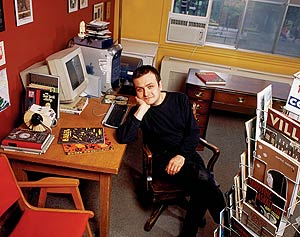
MARIE-LOUISE DERUAZ--KLIXPIX FOR TIME
DRAWN TO IT: Oliveros, at D&Q's offices in Montreal, tries to be a hands-off editor |
Oliveros' goal, he says, is to publish "the best cartooning work in the world." To achieve that, he keeps things small. Working out of a messy but colorfully decorated former dentist's office, he employs two full-time staff members and publishes only about 20 books a year. His pickiness and critical success have earned D&Q a monster reputation among the comixcenti and--with increased exposure in regular bookstores--the general public. In 2003, Oliveros says, D&Q racked up $715,000 in revenue, five times as much as in 2000.
With their hardcover bindings, thick paper stock and clean design, D&Q's long-form graphic novels defy preconceptions of what a comic should look like. These are keepsakes, not comics to be thrown away. Indeed, Oliveros, 38, has published nearly all of today's top talent, including Chris Ware, Joe Sacco and underground legend Robert Crumb. By showcasing national artists, he has almost single-handedly turned Canada into a major source of cartooning talent.
Oliveros got hooked on comics as a kid in Montreal, reading American superhero strips when that was about all one could get. At age 18 he attended art school in New York City but lacked focus. After two years he returned to Montreal, earned a liberal-arts degree and held a series of odd jobs. At age 23, inspired by RAW, a comics magazine published by Art Spiegelman and Franoise Mouly in the 1980s, Oliveros dreamed up a forum for short stories in comic-book form that he hoped would be, he says, "like Harper's or the New Yorker." The result was the four-times-a-year anthology Drawn & Quarterly. He didn't initially plan to publish anything else. "But," he says, "as we were looking for material to put into the anthology, I realized there were quite a few people doing longer works that wouldn't fit." And so he began publishing stand-alone works.
His early stable of artists included Canadians Chester Brown and the one-named Seth, who have since become two of North America's top cartoonist talents. Last year Brown scored a surprise hit with his biography of Canadian mystical rabble-rouser Louis Riel (see below). D&Q hopes for similar success with Seth's just-released Clyde Fans Book One. The first of a planned two-part series, Clyde Fans tells the wistful history of two brothers and their family electrical-fan business. Seth, n Gregory Gallant, 41, got the idea for the book from an old storefront office of the same name in Toronto. "I used to look into the window when I walked by," Seth says, "and in the dim light you could see on the back wall photographs of two men who were probably the owners. Over the next couple of years I put together a story of what these guys were about, although it probably had nothing to do with their real lives."
Drawn with a palette of black, gray and pale blue, Clyde Fans exudes a melancholy nostalgia. The first half of the book follows older brother Abraham, long retired, as he passes a lonely day. We see him take a bath, fix himself tea and move some boxes around, all while delivering a monologue about his days as a salesman. The second half follows brother Simon, 40 years earlier, on an unsuccessful attempt at opening new sales territory. Using nearly as many silent, atmospheric panels as there are panels of people talking, Seth creates a quiet, elegiac atmosphere. Deliberately pitching itself against the garish, high-impact antics of other comics, Seth's graphic novel fits perfectly into the D&Q aesthetic.
As an editor, Oliveros is hands-off. "You can't really say to a cartoonist, 'This drawing on page 3, panel 4 is a bit weak,'" he says. And the talent appreciates that. "It's a pretty simple arrangement," says Brown. "I do the work and send it to them, and they publish it." Given Oliveros' demanding taste, the D&Q roster is small and top-notch. "I have always believed that there is just not that much good work out there," says Oliveros. For that reason he expects D&Q to grow, but not much. "That," he says, "would go against the whole raison d'tre of the company."
